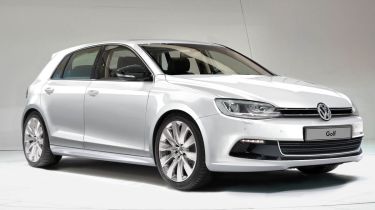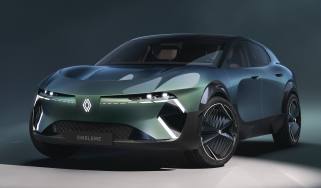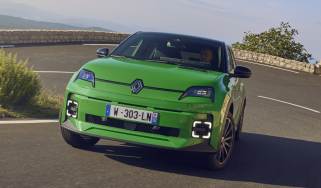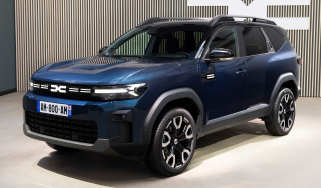New Golf: Official details
The Volkswagen Golf MkVII is nearly here, and we have the full technical story behind the new car
Volkswagen has revealed a host of details on the new Golf, ahead of its official unveil on 4 September. The biggest news is that it will be bigger, 100kg lighter and that the most efficient BlueMotion model will emit just 85g/km of CO2.
VW has refused to release any official pictures of the car before 4 September, but our artist's impressions and spy shots give a good idea of how the car will look.
The new Golf is the first VW to be built on the new MQB platform, which was debuted by the new Audi A3. The Golf will be bigger than the car it replaces, too, with a wheelbase that's 59mm longer and a body that's 56mm longer, 13mm wider and 28mm lower. The front axle - which will come with a locking differential that was previously only on sports models to aid cornering - sits 48mm further forward, giving the Golf a larger footprint and better stability.
Despite its larger size, the Golf has shed an amazing 100kg across the range, which means the entry-level version will weigh just 1,150kg – you have to go back to the 1997 Mk IV to find a Golf that weighs as little as this.
The improvements are due to the use of high-strength steel and more advanced manufacturing processes that allow thinner, stronger body sections. The body itself now weighs 23kg less, but components – such as the air-conditioning (which saves 2.7kg) and the front seats (now 7kg lighter) – have been improved, too.
We had the chance to sit inside a prototype of the new Golf, and it has a markedly different feel to the current car. The driving position is 12mm lower, and the seat itself has more adjustability in length.
While there’s less headroom - thanks to the lower roofline and ride height - there’s more leg and elbow-room, with rear passengers benefitting from most of the 14mm increase in overall cabin length.
Stretched before the driver is a new ‘driver oriented’ cockpit, which in VW speak means that the centre console is angled towards the driver, not like the current car’s flatter set-up.
There's a new infotainment system, too, which uses a 5-inch display on entry-level models, a 5.8-inch colour display on mid-level cars and a massive 8-inch WVGA screen on range-topping models. While they’ll all be capable of controlling the audio and air-conditioning settings, high-end versions will feature 3D sat-nav and be combined with new ‘Heptactic’ touch, which senses your finger approaching the screen and switches from display to operating modes.
This is part of the increasing customer demand for technology: “We feel Haptic Touch is brand relevant. Phaeton has the same,” says Head of Electronic Development, Dr Volkmar Tanneberger.
The touchscreen can also be used to zoom in on maps, for instance, as well as select music from a 64GB hard-drive. Bluetooth, USB, auxillary and SD card connectivity, as well as the ability to read all file formats, ensure Golf owners won’t be without music.
The centre display also takes care of trip computer data, while the soft-touch dash is scalloped towards the driver, with more detailed switchgear and similar white-on-black instrumentation. The switchgear has a quality feel, while practicality is even better as the conventional handbrake has been replaced by a smaller, electronic version, allowing for a larger centre console.
The Golf is also big on safety, with Adaptive Cruise Control, City Emergency Braking, Front Assists and Lane Assist. For enthusiasts, there’s optional Dynamic Chassis Control and a ‘progressive’ steering set-up.
The boot is up by 30 litres, which means the new car will match the Ford Focus with 380 litres. Access will be excellent thanks to a wider opening and lower lip, as well as 60/40 split-fold rear seats.
VW has confirmed that its most efficient model, the Golf BlueMotion TDI, will achieve 88.3mpg and emit 85g/km - the best in class. Also confirmed is a 138bhp 1.4-litre turbocharged petrol engine, which achieves 58.8mpg.
On average, the new Golf is 23 per cent more fuel-efficient and produces 13.9 per cent less CO2 – these figures don’t include an all-electric version that’s due next year.
Production of the five-door model has already begun, with a 220bhp 2.0 TSI GTI concept expected to be shown at the Paris Motor Show. The Golf Plus, Estate and Cabriolet will continue in MKVI form for the time being.
The new Volkswagen Golf will make its public debut at the Paris Motor Show at the end of September, before going on sale in December with first deliveries in January 2013. Prices are expected to start from around £15,000.







